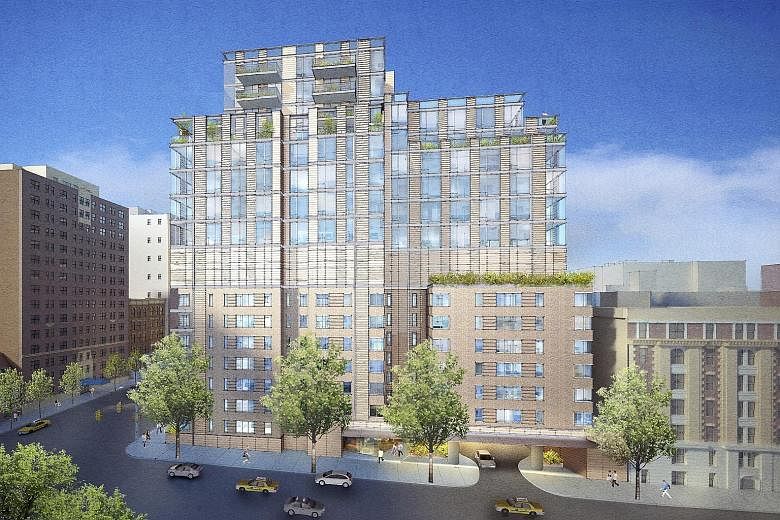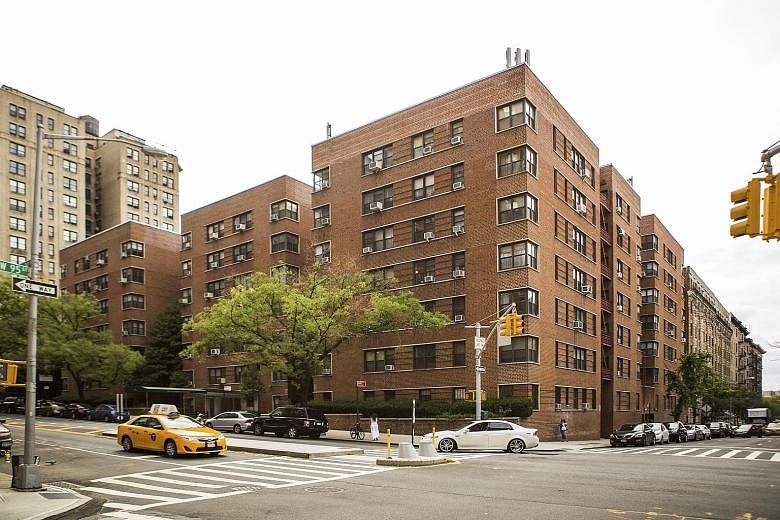NEW YORK • Two years ago, while walking his family's new puppy, Mr Paul Boardman had the kind of epiphany only a real estate entrepreneur can have.
A developer who was once the lead designer for all the Equinox gyms, he was passing by 711 West End Avenue in Manhattan, a seven- storey apartment building of red brick and squat windows between 94th and 95th streets that looked almost as if it were shrinking from the grand pre-war buildings around it that are twice its size.
He envisioned something equal in stature for the site. But tearing down the building would be impossible, considering that most of its 144 apartments are rent-stabilised, giving their tenants the right to stay.
So he came up with a daring plan. By threading a series of multi- tonne support columns around the existing structure, a new 10-storey condominium tower could be built. It would essentially sit not atop the old building, but above it, with its bottom floor hovering more than 24m in the air.
"We get to unlock the value of this site and create a building truly worthy of this great neighbourhood without displacing any of the existing residents," he said in a recent interview.
In a city where the only place to go is often up, adding floors to an existing building is nothing new. But rarely, if ever, is this work undertaken over an occupied apartment building.
"The idea is genius," said Mr Jesse M. Keenan, research director at the Center for Urban Real Estate at Columbia University. "The execution will be challenging, but not impossible."
The soon-to-be downstairs neighbours are not so enthusiastic. Tenants in about half of the apartments at 711 West End Avenue have formed a group opposing the project, contending that the blueprints do not begin to convey what the project will look and feel like from below.
"I'm afraid for my life that any minute, one of these three-tonne steel beams could come crashing through my wall," Ms Stephanie Cooper, a resident of 47 years, said in her two-bedroom apartment on the fourth floor.
She originally paid US$267 a month and now pays less than US$2,000 (S$2,800).
While building a 10-storey building over a seven-storey one might seem like a futuristic proposition, the engineering for 711 West End Avenue is quite conventional, certainly when compared with all the cantilevered building extensions and 300m-tall and 15m-wide towers on the horizon.
Here, the top 10 floors will sit on a steel-and-concrete platform supported by a criss-crossing steel superstructure surrounding but not touching the lower building.
Other than the shaft for a new lift and fire stairs that will run from the lobby to the new eighth floor, the buildings are totally separate.
A roughly 1.8m gap will separate the roof of the existing 1952 building and the bottom of the new one because they must comply with different fire codes, though the facade of the Art Deco-inspired addition will obscure the gap.
The idea is to unify the buildings visually but not physically.
"We hired all the best consultants and it's pretty amazing what they've come up with," said Mr Boardman, who is teaming up with the Miller family, which has owned 711 West End Avenue since the 1960s, and SJP Properties, a large New Jersey developer.
Some of the Millers live in the building, as do two of Mr Boardman's relatives who recently moved in. The owners point to this as proof they will take the utmost care during construction.
Those in the tenants' group remain suspicious.
They say they are worried not only about the risks posed by two or more years of construction above them, but also the continuing impact after the building is finished, such as how the new steel structure might overshadow their windows.
The group hired its own engineer to challenge the developer's tenant safety plan, arguing it is insufficient.
And the boards of the neighbouring co-op buildings and parents at a public school across have joined Councilman Helen Rosenthal to oppose the project, calling it a danger to surrounding properties.
Even so, the city's Department of Buildings approved permits for the project last June, though it did subject the plan to additional scrutiny, including a review by its high-rise investigations team and an independent engineer.
The owners maintain that the project will be a boon for current residents as well as new ones, and not only because they get to stay. The plans also call for adding new windows and central air-conditioning to all existing units, as well as a new lobby and a courtyard garden.
Despite the opposition, some residents said they are looking forward to the expected improvements.
A tenant of two years, Mr Zoran Nikolin, sounded unbothered by the coming work.
"It's going to be great for everybody. But we have to endure the nuisances for that to happen."
NEW YORK TIMES


